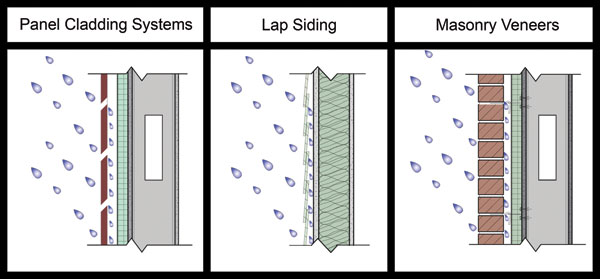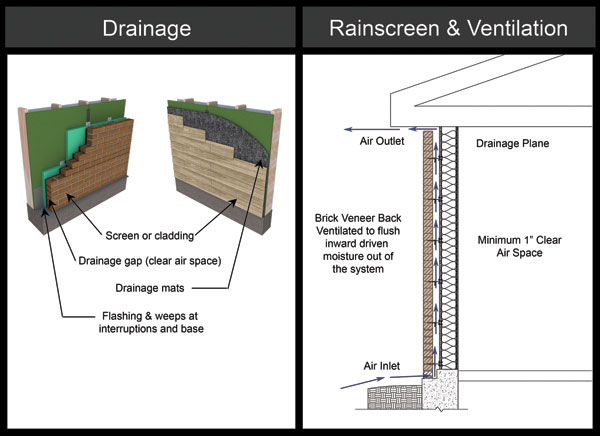Air, Water, and Moisture Management in Light Commercial Building Envelopes
In a building, moisture is transmitted through gross or liquid water, air, and vapor, in descending order of potential damage to a building envelope. Like all substances, water can exist in three phases: solid, liquid, and gas. A substance's phase essentially depends on the average speed of molecular motion. When water is a gas or vapor, the molecules are free to move about—they “run free.” In liquid water, the molecules are attached to each other; this allows liquid water to assume the shape of its container. Bulk water—rain, runoff, and other flows—is driven primarily by gravity and also by capillary action, or wicking, which is the ability of a liquid to flow in narrow spaces without the assistance of, and in opposition to, external forces like gravity. This can cause water to enter through very small gaps, e.g. between flashings and a cladding. Moisture vapor diffuses into and through a wall according to moisture and temperature gradients—that is from a region of high vapor concentration to a region of low vapor concentration, and from the warm side of a wall to the cooler side.
In terms of presenting risk to a building assembly, not surprisingly, liquid water carries the greatest risk. Driven by gravity or air pressure differences, water in liquid form can be carried into a building through holes and cracks. Air carrying water vapor moves with air, and carries a moderate risk. The lowest risk is presented by vapor, which moves through the air.
It is important to note here that walls and roof systems are very similar, and layers that make up both are essentially the same, and the concepts discussed—water, air, and vapor management—will apply to both systems.
Liquid Water Control Strategies—The Four Ds
Moisture can and will get into a structure—and fast. Liquid water can move through brick in about 20 seconds. Because water does get behind all facades, it is advisable to have a good secondary water barrier. Four key strategies, known as the Four Ds, keep moisture from getting into a building. They can be applied at the level of design and the level of detail. Essentially the Four Ds are predicated on the following two notions: The principal objective is to prevent moisture from getting into the structure in the first place (deflection); but any moisture that does get into the structure must be managed as quickly and thoroughly as possible (draining, drying, and durability).
Deflection. Keeping rainwater off the wall and other main entry points is the first line of defense. If water cannot reach a joint or junction, the possibility of leaks is greatly reduced. The first means of deflection is in the design of large roof overhangs, peaked roofs, and/or a face-sealed approach. Overhangs and peaked roofs have been shown to reduce rain deposition by 50 percent. Attention should be paid to drip edges, which help deflect water away from the structure.

Image courtesy of Huber Engineered Woods
Allowing for drainage is the method used for water that is not deflected away from the structure and/or enters into the wall assembly.
Drainage. Water must be able to drain off the face of the building. In a wall assembly, drainage involves methods that move water out of the wall; any water that penetrates the exterior cladding must be drained back out via drainage paths specifically designed into the wall assembly. A typical drainable wall system controls water infiltration through kinetic energy (raindrop momentum), gravity, surface tension, and capillary action. In order to create effective drainage within a wall assembly, the following elements should be incorporated into the design: screen or cladding; a primary water shed layer (for deflection); a secondary water-resistive barrier; a drainage plane, or a water-repellent plane; a drainage gap, which is often a clear air space; and weep holes or flashing at areas of interruption and at the base. With no weep holes, water gets trapped behind the facade and can't drain out. In some cases, the water can be wicked up through the exterior cladding.
Drainage mats are also available as a method to create a clear, drainable space. As can be seen in the accompanying illustration, brick veneer should be back ventilated to flush inward-driven moisture out of the assembly. The recommendation of a drainage plane has been commonplace, but most building scientists are now pushing for an air gap as well. A clear air space should be provided that is open at both the bottom and top of the plane, the theory being that an air gap will allow for drying (through convection) should moisture penetrate the exterior cladding or allow an unobstructed space for water to drain out should there be a leak higher up the wall assembly. An air gap for brick is common, and air gaps can easily be created with furring strips for most exterior claddings. Generally, a ¼-inch gap is recommended to prevent capillary action.

Image courtesy of Huber Engineered Woods
For best results, drainage details should be carefully considered.
Drying. Water that cannot be drained immediately should be dried as quickly as possible principally through diffusion and ventilation. The drying potential of a wall is affected by several factors including evaporation rate from surfaces; vapor movement by diffusion or air leakage; drainage by gravity and convection; and air movement. The key thing to note here is that when the wetting rate exceeds the drying rate, problems accrue. In order to maximize drying potential, air gaps should be utilized as should products that don't absorb water and products that let liquid water readily pass through them.
Durability. The moisture tolerance of the materials in the wall assembly is a key consideration, with architects well advised to select exterior cladding and wall assemblies that meet durability requirements of the prevailing building code. Durable materials are a fourth line of defense when the others—deflection, drainage, and drying—have failed. Some claddings, like brick veneer, are inherently durable, while others may require an exterior finish.

Image courtesy of Huber Engineered Woods
The OSB panel with integrated moisture barrier results in a streamlined installation and superior moisture management.
Most mistakes occur under the drainage category with the use of improper flashing, ineffective water-resistive barriers, and non-continuous air barriers. By this time, many designers realize that avoiding vapor barriers is important.









